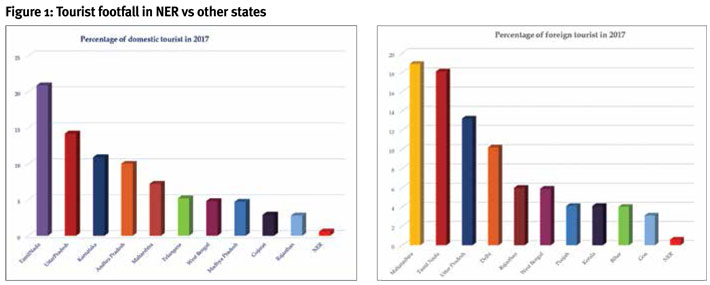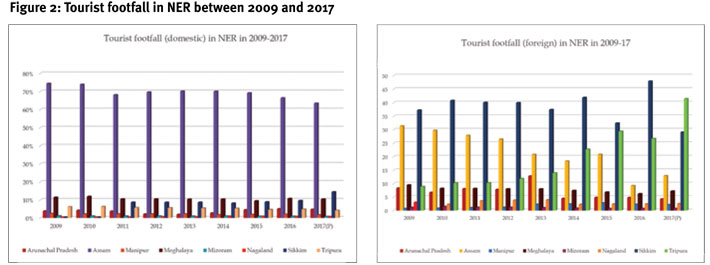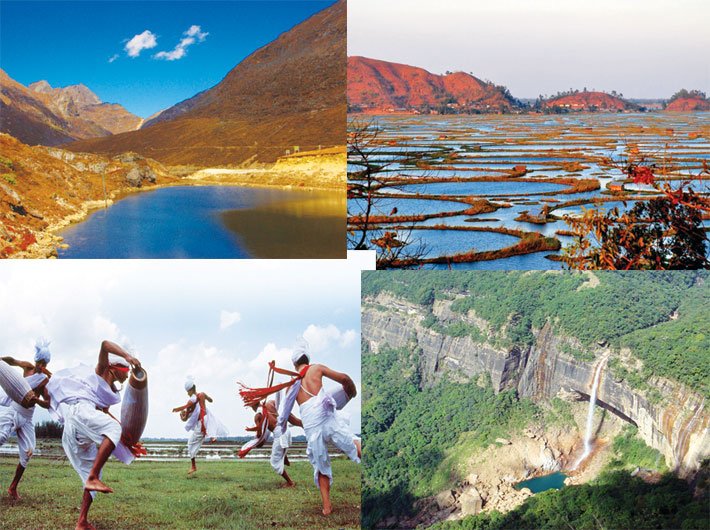The northeastern region (NER) is known for its lush green hills, vast flourishing plains, deep valleys, natural caves, free flowing rivers, large variety of flora and fauna, cuisines, and for its hospitable and friendly people. For long, the region has remained terra incognita to most travellers around the world. Coincidently, the very factor which kept industrialisation and commercialisation at bay is also responsible for low tourist footfalls in the region. This is clearly illustrated when we compare the footfall of tourists in top ten tourist attracting states in India with the NER (Figure 1).
In 2017, Tamil Nadu and Maharashtra clocked highest tourist footfall in the domestic circuit with 20.9 percent and 18.9 percent respectively. For the same period, NER accounted for a mere 0.57 percent and 0.62 percent in terms of domestic and foreign tourist footfall respectively, and this is for the entire region and not individual states. A quick glance at Figure 2 shows that barring Assam (for domestic) and Sikkim (for foreign), the other six northeastern states have been constant underperformers in the tourism.
This is indeed unfortunate. Despite having a plethora of tourism opportunities such as ecotourism, adventure, cultural, heritage, river and lake tourism, the NER is yet to make any distinct appearance on a travellers map. This can be attributed to several constraints, such as lack of connectivity, infrastructure bottlenecks, security issues, requirement of special permits, and most importantly lack of promotion of the region. These challenges will require a complete overhaul of existing practices, but many challenges can also be resolved by tweaking existing policies.

In the last few years, the central government has been proactive in promoting tourism in the NER. For example, under the Swadesh Darshan Scheme, started by ministry of tourism, the centre has sanctioned a cumulative amount of Rs. 69,364 crore between 2015 and 2018 for the development of eight different circuits. The ministry has introduced a northeast tourist circuit for specifically promoting tourism in NER. Further, the centre has sanctioned Rs. 33.98 crore to the government of Assam and Rs. 35 crore to the government of Tripura under the National Mission on Pilgrimage Rejuvenation and Spiritual, Heritage Augmentation Drive (PRASHAD), for development of the two Shaktipeeths, the Kamakhya temple and the Mata Tripura Sundari temple, in their respective state. Each state has been trying to increase their revenues from tourism by augmenting tourism infrastructure and rejuvenating major tourist destinations, but with minimal success. It would be in the best interest of the region to adopt a more holistic approach to tourism for NER. This calls for a collaborative effort from all eight states to create a framework which will resolve basic issues like connectivity, security, and infrastructure.
Boosting tourism
First, all states must have their own state tourism policy with clear goals and time bound objectives. Of the eight states in the NER only Assam, Sikkim, Meghalaya and Manipur have their own state tourism policy. To develop an effective tourism circuit in the region it is imperative that the remaining four states too draft their own tourism policies with concrete short, medium, and long-term goals. A separate monitoring and evaluation department should be formed under the guidance of North-East Council (NEC) for tracking the implementation and progress of these objectives.
Second, private sector entities should be encouraged and incentivised to set up base and develop small industries, handloom and handicraft, agro processing, alternative medicine (medicinal plants), and other locally relevant sectors. These will enable surrogate promotion of tourism in the region.
Third, policymakers must focus on fostering accessibility in the region. Most tourist destinations in the northeastern states are inaccessible due to lack of last-mile road or rail connectivity. Some destinations are on terrains where building roads or rail may lead to destruction of the ecological balance of the area. To make these places accessible, state governments should build mini air strips in these areas for small aircraft. Operation of smaller aircraft on these routes will have a dual impact on tourism. First, it will ease the burden of road travel and would be less time intensive. Second, operation of smaller aircraft will ease the burden of commercial flight operators who do not wish to operate on smaller routes due to low passenger traffic. This would also enable tourists to avail air travel at cheaper rates than commercial flights. This development can take place under the UDAN (Udega Desh ka Aam Nagrik) scheme or regional connectivity scheme (RCS) of the government of India, which aims to develop regional air infrastructure.
Fourth, safety and security have been major concerns in NER. Hence, governments of all eight states should join hands to fight against terrorism and ensure the safety and security of tourists going to the northeast. A separate ‘Tourism Police Force’ can be introduced to boost safety which would also help in easing the burden partially off the state police departments. This concept has been recently adopted by Nagaland for the 2018 Hornbill festival. Moreover, inner line permits and area restrictions should be limited to border areas and not to entire states. The state governments may discuss this with relevant central authorities to find a suitable solution.

Fifth, promotion and publicity of the north eastern region should be actively pursued at both national and international platforms. Publicity ads on the lines of ‘Desh Raag’ and ‘Mile Sur Mera Tumhara’ but specific to NER, can be made to promote the region better. Setting up kiosks and display units for promoting northeast tourism at major domestic and international airports in India and abroad, at railway stations, and inter-state bus terminals (ISBTs) is vital to drawing attention to the NER. Further, allowing for a single window clearance for shooting documentaries and movies in NER would boost tourism manifold. Organising festivals such as northeast food and cultural festivals across the country would also help in better promotion of the region.
Apart from these, there is a need for an out-of-the-box approach to develop new niches for NER tourism. For example, developing a festival circuit in the NER is a possible new area to explore. The festival circuit would cover all major festivals such as Sangai, Hornbill, Ziro, Orange Festival, and other state specific festivals. These festivals can be organised nearer to the dates of each other so that tourists can plan one single trip to cover them all. Moreover, these festivals can be made popular by inviting local talent to perform during the festivals.
The state governments may also organise photography, videography, creative writing, and travel blogging competitions during these events which will promote these places among the masses. Furthermore, five northeastern states share international borders with three different nations. The NER could utilise this to develop a border tourism concept.
The Himalayan Region Games has been reasonably successful in attracting tourist and sports enthusiasts from neighbouring countries. Along the same lines, setting up a high-altitude games and winter sports training school in Arunachal Pradesh would encourage sportsmen to travel there too. Similarly, an integrated folk music and cultural institute for indigenous art and culture in the northeast would boost tourism through cultural exchange. Furthermore, the cold deserts of Sikkim have an uncanny resemblance to those of Ladakh. If developed, these can prove major tourist attractions especially for bike trips, mountain car rallies, and off-road travel tours.
The northeastern states of India have abundant scope to transform into one of the most attractive tourist hubs not just in the country but across the world. Increasing tourism in northeast India will not only boost revenue generation for the region but will also provide livelihood to a large number of unemployed people in the region. For the prime minister’s dream of making NER the highest revenue grossing region in India, it is important for the northeastern region to work together and not in silos. Only then will the true potential of the area be unleashed.
Goswami is fellow and Hazarika is senior research associate at Pahle India Foundation. Views are personal.
(The article appears in January 15, 2019 edition)
